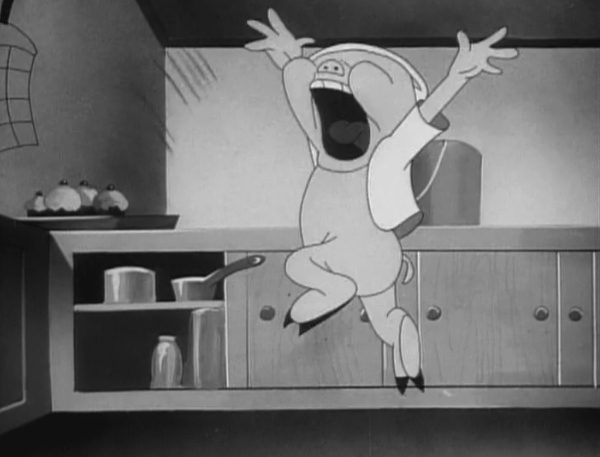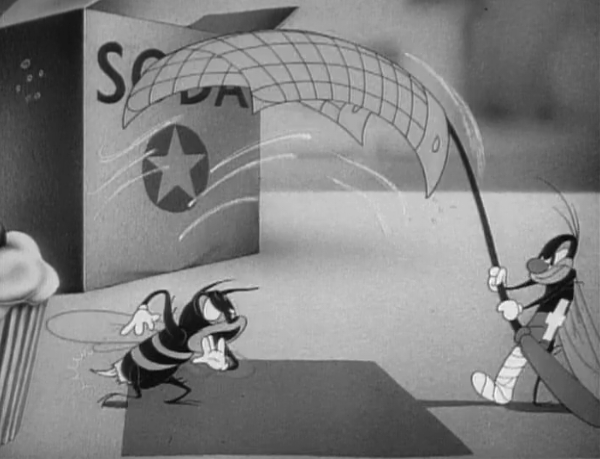Warner cartoon no. 353.
Release date: January 17, 1942.
Series: Looney Tunes.
Supervision: Friz Freleng.
Producer: Leon Schlesinger.
Starring: Mel Blanc (Porky Pig), Kent Rogers (Jimmy Cagney bee).
Story: Dave Monahan.
Animation: Gerry Chiniquy.
Musical Direction: Carl W. Stalling.
Sound: Treg Brown (uncredited).
Synopsis: A Jimmy Cagney-like bee demonstrates towards the fly how to avoid Porky's flyswatter whilst invading on eating the food inside his bakery store.
From watching the synopsis of the short, it's the sort of plot device you'd wish to see from previous shorts like Porky's Midnight Matinee, but no matter for it's used as a fresh idea in the cartoon. A hungry fly is having troubles of invading the food inside Porky's bakery shop, due to his fear for file.
 This is an establishing dilemma to sum up most of the cartoon: Porky battling against flies. Might sound mundane, but Monahan has some pleasant surprises along the way.
This is an establishing dilemma to sum up most of the cartoon: Porky battling against flies. Might sound mundane, but Monahan has some pleasant surprises along the way. A passing-by bee, whose persona is impersonating Jimmy Cagney, demonstrates towards the fly how it works. The opening scene is a great way to start up the cartoon, for the Cagney-bee has a brash type of personality, who says "it's a cinch" when it comes to raiding bakers.
A passing-by bee, whose persona is impersonating Jimmy Cagney, demonstrates towards the fly how it works. The opening scene is a great way to start up the cartoon, for the Cagney-bee has a brash type of personality, who says "it's a cinch" when it comes to raiding bakers.
The subtle scene of him winking at the audience is a decent piece of character for the cocky bee, suggesting that his specie (being a bee) is far superior than the fly itself. Kent Rogers does a decent impersonation of the Cagney character, with the voice being a duplicate to the Cagney caricature in Hollywood Steps Out.
Porky's role in the cartoon shows him as a passive, vulnerable character...perhaps a little more vulnerable than the other cartoons beforehand. Not to mention, he's always been a victim of vulnerability in his prime, but here..the characterisation is still being experimented in the short, as Porky's too massive a character to be hilarious.
Sure, he expresses his hatred towards flies, and uses his flyswatter as a weapon: but the tricks and gags pulled towards him would be of better use if it were a Elmer Fudd characterisation, not for Porky.
 Despite the minor flaw, the contrast of size between the two characters are polar opposites in pompous personalities. Porky discovers that a bee has invaded his bakery shop, and has a fear of bees. This leads him to command and instinctively obeys the bee, such as in the cream puff scene.
Despite the minor flaw, the contrast of size between the two characters are polar opposites in pompous personalities. Porky discovers that a bee has invaded his bakery shop, and has a fear of bees. This leads him to command and instinctively obeys the bee, such as in the cream puff scene.
Other instances where his vulnerability becomes amusing in execution would be the scene of Porky pulling a sheepish, timid grin as he attempts to grab the flyswatter, but is prevented from the presence and disturbance of the bee. Porky then attempts to settle the bee with a cherry topping from a piece of cupcake, which he refuses sternly. He storms off, but only to storm back to eat the piece of cherry in his mouth.
From Monahan's writing and gags; he indulges into gags that rely on visual puns, and at least creates puns that are comical and entertaining to that effect. The visual puns consist of several different kinds of cakes, which you'd expect to see on display in a bakery shop.
One of the cakes that the bee invades is the "Marble cake", and as you'd expect: the visual pun is that the cake itself is made out of marble. The animation timing of the bee using his bee sting is ingenious and meticulous, but the gag succeeds.
Other great scenes that create puns themselves would be another shot of the bee who is seen raiding other cakes in display. To begin with, he starts off with a "cheese cake", and as you'd expect there's no visual pun there, but then he gets to the "limburger cheesecake", which turns itself into a pun and a humorous gag itself. From eating the piece of limburger, he spits out the taste from his mouth. Though, its deliberately created for gag purposes, limburger is notorious for its smell and taste which doesn't appeal to a lot of people.
 As for Freleng's ingenious comic timing, you'll find that circulating over the cartoon. The scenes that stick to my mind with Friz's timing would be the use of the bee's sting; which has some monument force towards it. He appears to give the bee's sting to appear rather symbolic in terms of what power it can outcome. Note how in the scene where the bee breaks the doorknob to Porky's front door down, and you feel the immensity and power that created the spark.
As for Freleng's ingenious comic timing, you'll find that circulating over the cartoon. The scenes that stick to my mind with Friz's timing would be the use of the bee's sting; which has some monument force towards it. He appears to give the bee's sting to appear rather symbolic in terms of what power it can outcome. Note how in the scene where the bee breaks the doorknob to Porky's front door down, and you feel the immensity and power that created the spark.  Not to mention, Treg Brown adds the right elements to the bee with the sound effect which would later become a more well-known associate to the Tasmanian Devil. Other instances where Freleng's timing comes to great use would the spark effect he gives to Porky's flyswatter.
Not to mention, Treg Brown adds the right elements to the bee with the sound effect which would later become a more well-known associate to the Tasmanian Devil. Other instances where Freleng's timing comes to great use would the spark effect he gives to Porky's flyswatter.
Porky, regaining his confidence is in search for the bee; who had squirted cream puff at his face. The Cagney bee, flies towards his flyswatter, and gives the swatter a powerful sting that creates a socket/spark effect that it generates voltage towards Porky. It's a great, powerful piece of timing that's also comedic fun.
Looking more into Friz's timing; you notice that the short shares its great energy and pacing that can be comparable towards Frank Tashlin's use of quick pacing. Once Porky discovers that his shop is being invaded by a bee, he shouts: "Yipe! A bee", and frantically rushes through the back of store in such speed. The use of its staging and effect can be comparable to what Tashlin had some in the 30s, working for Schlesinger; though both directors had their own flair when it came to energy and speed.
Areas of the cartoon where Dave Monahan contributes gags that can surprise you, you'll find that in scenes such as the Gingerbread man. The bee walks past a box of gingerbread men in display, with a gingerbread man standing. He pulls the lower button of his body, which leads to them dropping down like a pair of pants. The Gingerbread man pops to life and pulls up his shirt with an embarrassed take. It's a great, charming scene which you'd expect from the wacky mindset of Bob Clampett, but Freleng shows how he doesn't mind a cheesy gag to surprise the audience.
 After a series of misadventures, the Cagney bee is next seen outside the shop's window sill where he showed all the business to the fly, which he did throughout the short. "See how easy it is, kid?" asks the Cagney bee, and then becomes to plot with the fly to help make the plan work.
After a series of misadventures, the Cagney bee is next seen outside the shop's window sill where he showed all the business to the fly, which he did throughout the short. "See how easy it is, kid?" asks the Cagney bee, and then becomes to plot with the fly to help make the plan work.  And so, he disguises the fly to resemble the look of a bee. Then he wishes him luck, "You do your stuff and I'll see ya later".
And so, he disguises the fly to resemble the look of a bee. Then he wishes him luck, "You do your stuff and I'll see ya later".
Walking inside the bakery store, the fly walks quietly through the table and finds to his delight a nice piece of cake on display. He jumps on top of the cake and begins to swim around on top of the icing. Some great effects animation to make the icing symbolise like its runny water: and plus emphasising the fly's moment being paradise. And so, he continues to roll around the icing in a blessing moment, until his disguise and plan goes all wrong. He is seen watched by Porky, with a flyswatter in his hand, and the fly ends up cornered. The plan goes all wrong.
This then leads to a chase sequence where the fly runs for his life as Porky shows no mercy by hitting him mercilessly with the flyswatter. Note how Freleng times the sequence in rhythm to the popular song: You Hit My Heart with a Bang, which is a great piece of timing to make the fly swatting scenes appear less cruel and more comical to that effect.
This leads to the following exterior shot of Porky seen from a window view chasing his flyswatter all over his shop, which once again is a more subtle approach to humour, for he is chasing the fly all over the place from that view, making him look a little like a hick.
But then, Porky opens the door and kicks the fly out, ordering: "Get out and stay out you unsanitary old fly!". Later on, the Cagney bee flies towards the shop wondering, "I wonder how that jerk fly made out". Flying inside the bakery store again, the suspense becomes intense as the flyswatter appears to scene but identified as a silhouette. This leads to him getting beaten up mercilessly in a close-up shot, but the following shot reveals the injured fly beating him up as payback. It's a great sendoff to the short, and thus a good use of justice for the Cagney bee crook.
Overall: it's a pretty decent effort once more in the hands of Friz Freleng. He takes the notion on two bugs attempting to invade a bakery store into account, and does a good job with timing as well as execution in certain scenes. The Cagney bee character is a great one-shot character whose arrogant personality and flamboyant attitude is a great dilemma for Porky, whose intimidated by bees, though justice is done for the bee. Porky acts a bit too vulnerable as a character, though it works well; for his fear of bees explains so, and the set-up of the Cagney bee taking advantage of Porky works well in certain sequences: making it a funny contrast when you compare both character in terms of their size. It is, as I've already explained: an all-round entertaining short, which isn't anything too special or groundbreaking in terms of approach to humour, and its a passable short along the way.
Rating: 3/5.





























